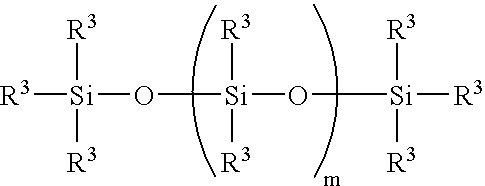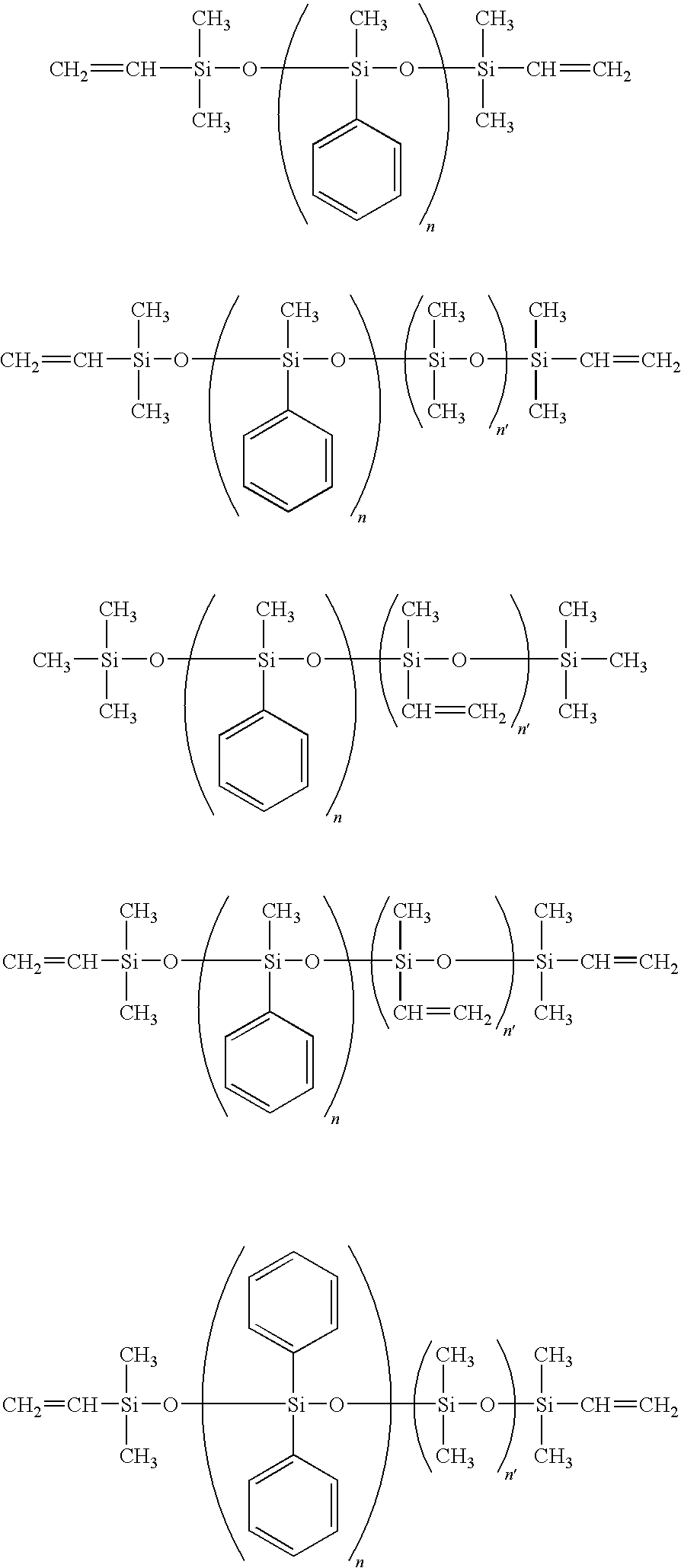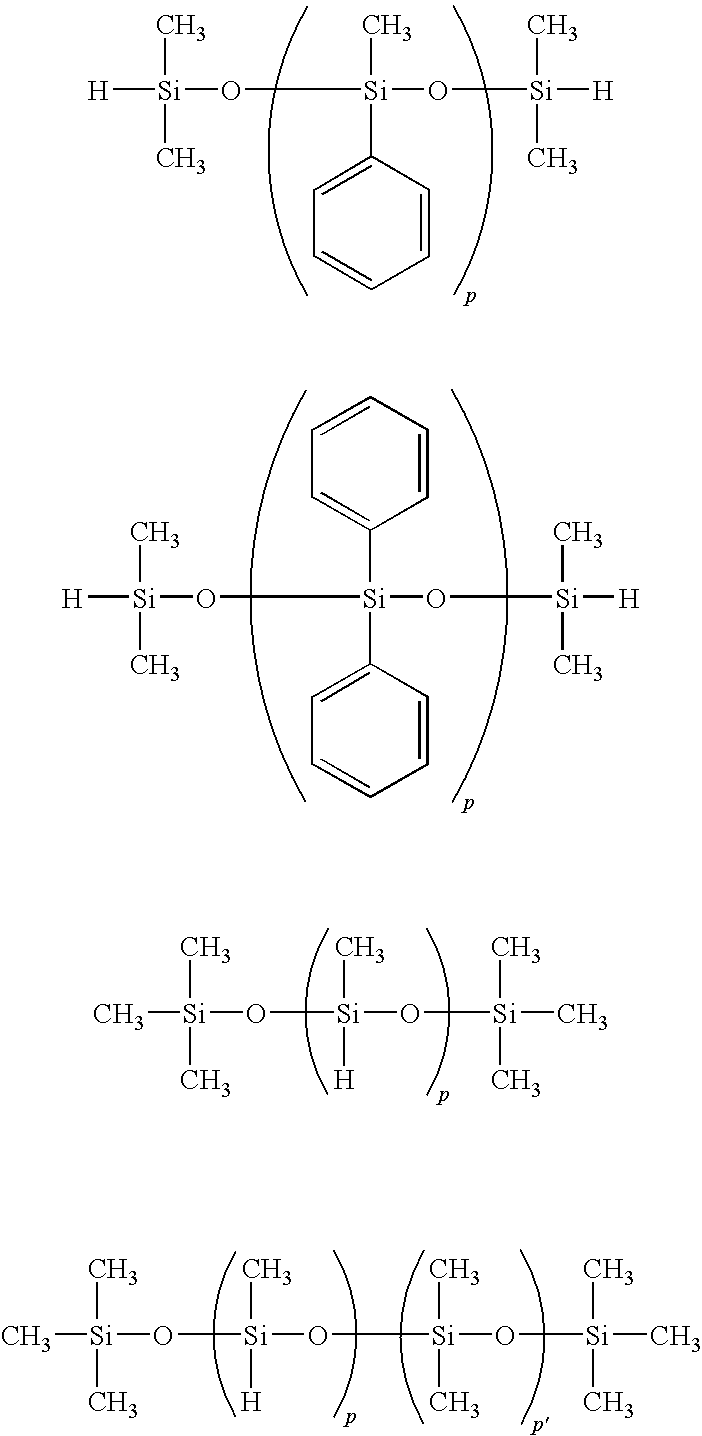Hot-Melt Silicone Adhesive
a silicone adhesive and hotmelt technology, applied in the direction of adhesives, thin material processing, layered products, etc., can solve the problems of insufficient gap-filling capacity of bonding sheets, inability to provide sufficient strength of adhesive connection, and insufficient properties, etc., to achieve good gap-filling ability, strong adhesion, and high surface roughness
- Summary
- Abstract
- Description
- Claims
- Application Information
AI Technical Summary
Benefits of technology
Problems solved by technology
Method used
Image
Examples
example 1
Practical Example 1
[0039]A toluene solution was prepared by mixing 60 parts by mass of Component A1, 26.5 parts by mass of component B 1, 13 parts by mass of Component C1 (used in such an amount that the mole ratio of silicon-bonded hydrogen atoms contained in this Component C1 to the sum of vinyl groups of Components A1 and B1 is equal to 1.5), 1 part by weight of Component D1, and 0.5 parts by weight of Component F1, and dissolving the mixture in 100 parts by mass of toluene. The solution was then additionally mixed with 0.02 parts by mass of Component E1. The obtained toluene solution was applied onto a fluorosilicone-treated PET film, and the toluene was removed by heating the coated film with hot air for 5 min. at 100° C. As a result, a PET film having a 50 μm-thick coating was obtained. Another fluorosilicone-treated PET film was laminated onto the first one, whereby a 50 μm-thick film-like reactive hot-melt silicone adhesive product coated on both sides with PET films was obt...
example 2
Practical Example 2
[0044]A toluene solution was prepared by mixing 60 parts by mass of Component A2, 26.5 parts by mass of Component B2, 8 parts by mass of Component C1 (used in such an amount that the mole ratio of silicon-bonded hydrogen atoms contained in this Component C1 to the sum of vinyl groups of Components A2 and B2 is equal to 1.9), 1 part by weight of Component D1, and 0.5 parts by weight of Component F1, and dissolving the mixture in 100 parts by mass of toluene. The solution was then additionally mixed with 0.02 parts by mass of Component E1. Similar to the case of Practical Example 1, a 50 μm-thick film-like reactive hot-melt silicone adhesive product coated on both sides with PET films was obtained by using the aforementioned solution. By the same methods as in Practical Example 1, the obtained silicone adhesive composition was tested with regard to a storage modulus of elasticity at 30° C., melt viscosity at 100° C., gap-filling properties, and adhesive properties, ...
example 3
Practical Example 3
[0048]A toluene solution was prepared by mixing 60 parts by mass of Component A1, 26.5 parts by mass of Component B1, 13 parts by mass of Component C3 (used in such an amount that the mole ratio of silicon-bonded hydrogen atoms contained in this Component C3 to the sum of vinyl groups of Components A1 and B1 is equal to 1.1), and 0.5 parts by weight of Component F1, and dissolving the mixture in 100 parts by mass of toluene. The solution was then additionally mixed with 0.02 parts by mass of Component E1. Similar to the case of Practical Example 1, a 50 μm-thick film-like reactive hot-melt silicone adhesive product coated on both sides with PET films was obtained by using the aforementioned solution. By the same methods as in Practical Example 1, the obtained silicone adhesive composition was tested with regard to storage modulus of elasticity at 30° C., melt viscosity at 1 00° C., gap-filling properties, and adhesive properties, while the cured product was tested...
PUM
| Property | Measurement | Unit |
|---|---|---|
| softening point | aaaaa | aaaaa |
| roughness | aaaaa | aaaaa |
| thickness | aaaaa | aaaaa |
Abstract
Description
Claims
Application Information
 Login to View More
Login to View More - R&D
- Intellectual Property
- Life Sciences
- Materials
- Tech Scout
- Unparalleled Data Quality
- Higher Quality Content
- 60% Fewer Hallucinations
Browse by: Latest US Patents, China's latest patents, Technical Efficacy Thesaurus, Application Domain, Technology Topic, Popular Technical Reports.
© 2025 PatSnap. All rights reserved.Legal|Privacy policy|Modern Slavery Act Transparency Statement|Sitemap|About US| Contact US: help@patsnap.com



